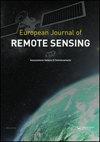Phenological piecewise modelling is more conducive than whole-season modelling to winter wheat yield estimation based on remote sensing data
IF 3.7
4区 地球科学
Q2 REMOTE SENSING
引用次数: 0
Abstract
ABSTRACT Most of the existing remote sensing-based yield estimation methods adopt the mean or cumulative value of meteorological factors within the whole growing season, which may ignore the impact of adverse meteorological conditions on the growth of winter wheat in a certain phenological period. In this study, we distinguished the developmental progression of winter wheat as three phenological periods. In each phenological period, the vegetation indices and meteorological factors were optimized. Then the accuracy and spatiotemporal transferability of the phenological piecewise modelling was compared with that of the whole-season modelling based on four regression methods (i.e. multiple linear regression, artificial neural network, support vector regression and random forest). The results showed that the optimal combinations of variables for the whole-season modelling and the phenological piecewise modelling were different. Compared with the whole-season models, the R2 for the phenological piecewise models improved by 1.4% to 7.6%, the root mean square error (RMSE) decreased by 1.1% to 8.2% among four regression methods . In addition, compared with the whole-season models, the spatiotemporal transferability for the phenological piecewise models was generally better. The accuracies after spatiotemporal transfer for the phenological piecewise models were still higher than that for the whole-season models.物候分段模型比全季模型更有利于基于遥感数据估算冬小麦产量
摘要现有的基于遥感的估产方法大多采用整个生长季节内气象因子的平均值或累积值,可能忽略了不利气象条件对冬小麦在某一生育期生长的影响。在本研究中,我们将冬小麦的发育进程分为三个酚期。在各生育期,对植被指数和气象因子进行了优化。然后,将基于多元线性回归、人工神经网络、支持向量回归和随机森林四种回归方法的苯酚分段建模与全季节建模的准确性和时空可转移性进行了比较。结果表明,全季节建模和分阶段建模的最优变量组合不同。与全季节模型相比,四种回归方法中,酚类分段模型的R2提高了1.4%至7.6%,均方根误差(RMSE)降低了1.1%至8.2%。此外,与全季节模型相比,酚类分段模型的时空可转移性总体较好。在时空转换后,酚类分段模型的精度仍然高于全季节模型。
本文章由计算机程序翻译,如有差异,请以英文原文为准。
求助全文
约1分钟内获得全文
求助全文
来源期刊

European Journal of Remote Sensing
REMOTE SENSING-
CiteScore
7.00
自引率
2.50%
发文量
51
审稿时长
>12 weeks
期刊介绍:
European Journal of Remote Sensing publishes research papers and review articles related to the use of remote sensing technologies. The Journal welcomes submissions on all applications related to the use of active or passive remote sensing to terrestrial, oceanic, and atmospheric environments. The most common thematic areas covered by the Journal include:
-land use/land cover
-geology, earth and geoscience
-agriculture and forestry
-geography and landscape
-ecology and environmental science
-support to land management
-hydrology and water resources
-atmosphere and meteorology
-oceanography
-new sensor systems, missions and software/algorithms
-pre processing/calibration
-classifications
-time series/change analysis
-data integration/merging/fusion
-image processing and analysis
-modelling
European Journal of Remote Sensing is a fully open access journal. This means all submitted articles will, if accepted, be available for anyone to read anywhere, at any time, immediately on publication. There are no charges for submission to this journal.
 求助内容:
求助内容: 应助结果提醒方式:
应助结果提醒方式:


